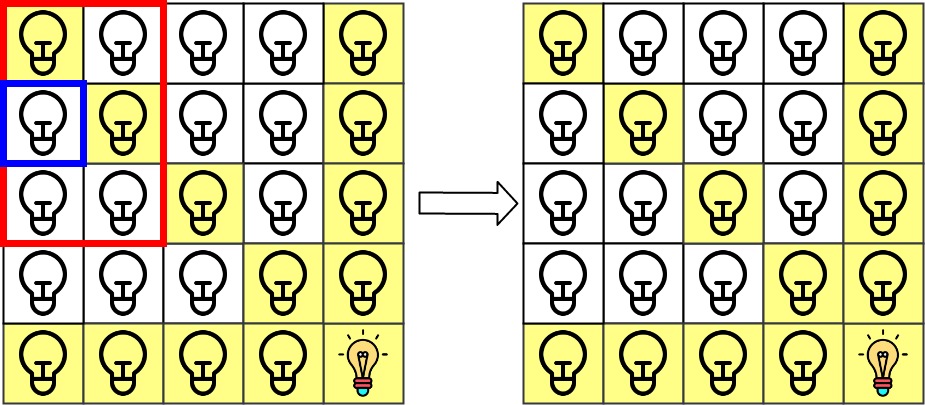- {x}
- Cousins in Binary Tree
- Rotting Oranges
- Minimum Number of K Consecutive Bit Flips
- Number of Squareful Arrays
- Find the Town Judge
- Maximum Binary Tree II
- Available Captures for Rook
- Minimum Cost to Merge Stones
- Grid Illumination
- Find Common Characters
- Check If Word Is Valid After Substitutions
- Max Consecutive Ones III
- Maximize Sum Of Array After K Negations
- Clumsy Factorial
- Minimum Domino Rotations For Equal Row
- Construct Binary Search Tree from Preorder Traversal
- Complement of Base 10 Integer
- Read More...

Grid Illumination
There is a 2D grid of size n x n where each cell of this grid has a lamp that is initially turned off.
You are given a 2D array of lamp positions lamps, where lamps[i] = [rowi, coli] indicates that the lamp at grid[rowi][coli] is turned on. Even if the same lamp is listed more than once, it is turned on.
When a lamp is turned on, it illuminates its cell and all other cells in the same row, column, or diagonal.
You are also given another 2D array queries, where queries[j] = [rowj, colj]. For the jth query, determine whether grid[rowj][colj] is illuminated or not. After answering the jth query, turn off the lamp at grid[rowj][colj] and its 8 adjacent lamps if they exist. A lamp is adjacent if its cell shares either a side or corner with grid[rowj][colj].
Return an array of integers ans, where ans[j] should be 1 if the cell in the jth query was illuminated, or 0 if the lamp was not.
Example 1:

Input: n = 5, lamps = [[0,0],[4,4]], queries = [[1,1],[1,0]] Output: [1,0] Explanation: We have the initial grid with all lamps turned off. In the above picture we see the grid after turning on the lamp at grid[0][0] then turning on the lamp at grid[4][4]. The 0th query asks if the lamp at grid[1][1] is illuminated or not (the blue square). It is illuminated, so set ans[0] = 1. Then, we turn off all lamps in the red square.The 1st query asks if the lamp at grid[1][0] is illuminated or not (the blue square). It is not illuminated, so set ans[1] = 0. Then, we turn off all lamps in the red rectangle.

Example 2:
Input: n = 5, lamps = [[0,0],[4,4]], queries = [[1,1],[1,1]] Output: [1,1]
Example 3:
Input: n = 5, lamps = [[0,0],[0,4]], queries = [[0,4],[0,1],[1,4]] Output: [1,1,0]
Constraints:
1 <= n <= 1090 <= lamps.length <= 200000 <= queries.length <= 20000lamps[i].length == 20 <= rowi, coli < nqueries[j].length == 20 <= rowj, colj < n
Solution Explanation: Grid Illumination
This problem involves determining whether specific cells in a grid are illuminated by a set of lamps, given a series of queries. The challenge lies in the large grid size (up to 109 x 109) and the efficient handling of lamp illumination and subsequent lamp removal.
Core Idea: Instead of explicitly representing the entire grid, which would be infeasible due to its size, we leverage the observation that a lamp illuminates an entire row, column, and both diagonals passing through it. We can track the number of lamps affecting each row, column, and diagonal using hash maps (dictionaries).
Algorithm:
-
Lamp Initialization:
-
We use a
set(orHashSet)sto store the unique lamp positions to avoid duplicate processing. -
We use four
Counterobjects (orHashMaps) to track the number of lamps affecting each:row: Number of lamps in each row.col: Number of lamps in each column.diag1: Number of lamps on each main diagonal (whererow == col).diag2: Number of lamps on each anti-diagonal (whererow + colis constant).
-
For each lamp
(i, j)inlamps, we increment the counts in the correspondingrow[i],col[j],diag1[i - j], anddiag2[i + j].
-
-
Query Processing:
- For each query
(i, j)inqueries:- We check if the cell is illuminated by any lamp: If
row[i] > 0,col[j] > 0,diag1[i - j] > 0, ordiag2[i + j] > 0, the cell is illuminated; we add 1 to the answer array. - We simulate turning off the lamp at
(i, j)and its 8 neighbors:- Iterate through the 3x3 area around
(i, j). - If a lamp exists at
(x, y)within this area, remove it fromsand decrement the counts in the correspondingrow,col,diag1, anddiag2.
- Iterate through the 3x3 area around
- We check if the cell is illuminated by any lamp: If
- For each query
-
Return Answer: The answer array containing 1 (illuminated) or 0 (not illuminated) for each query is returned.
Time Complexity:
- The initialization step takes O(m), where m is the number of lamps.
- Query processing takes O(q * 9), where q is the number of queries. The 9 comes from checking the 3x3 neighbor area. This simplifies to O(q).
- Therefore, the overall time complexity is O(m + q).
Space Complexity:
- The space used is dominated by the hash maps, which store at most O(m + n) entries (where n is the number of rows/columns, it will be dominated by 'm' usually), in the worst case.
- The set
scan store at mostmelements. - Thus, the overall space complexity is O(m + n). In practice, O(m) dominates if the grid is significantly larger than the number of lamps.
Code Examples (Python):
The Python code using collections.Counter efficiently handles the counting and updating of lamps affecting each row, column, and diagonal.
Note: The provided Java, C++, Go, and TypeScript codes follow the same algorithmic approach, adapting the data structures to the specific language. They effectively manage the large grid implicitly using hash maps/dictionaries. The use of long long or similar data types in C++ and Java is important for handling the potentially large n value without integer overflow.